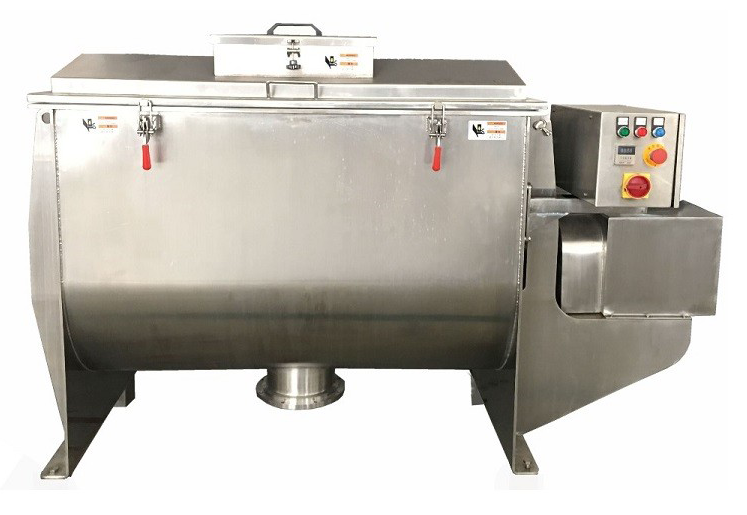

Ribbon Powder Mixer Food Grade Ribbon Blender
What is a ribbon blender and how does it work?
1. Principle of operation
Ribbon Mixers are a specific type of powder blenders that consist of 2 parts mounted on a central shaft . The mixing medium often consists of inner and outer helical ribbons that are designed to move material both inwards and outwards. The external helical ribbons pull product from the sides of the mixer into the middle and the internal ribbons push the product back to the sides. The back-and-forth folding motion of the materials to be blended creates a convective mixing pattern.
The ribbons are designed to have precise gap tolerances between the walls of the mixer. In some instances, they can even be designed with soft material wipers to help keep product from building up on the sides. The drive mechanism often consists of a belt drive for the powder transmission between the motor and gear box. This arrangement would use a system of flexible belts and pulleys to produce the desired speed and torque required for the specific mixing application. However, more manufacturers are starting to use direct drives via gear motors that utilize a motors low inertia rotor to specifically match the gearbox unit. The advantage of this arrangement means less maintenance over the life of the industrial mixer.
Make sure to understand the required volume capacity of the mixer you are in need of. Knowing the bulk densities of the ingredients to be mixed is crucial to understanding the required capacity of your mixer, and more importantly the needed motor power required to mix your batches properly. Most standard design mixers will work just fine with a product bulk density of 35 lbs./ft³. However, once you start mixing denser batches the need for heavy duty motors and gear ratio changes will also be required.
2. Main benefits of ribbon blenders
Ribbon mixers are the most versatile and widely used type of powder blending machine in the market. They often are most commonly used for solids on solids mixing but can also be used for applications involving coating a dry particle with a liquid ingredient, or even particle absorption of a liquid addition. Rarer applications do allow for slurry and liquid particle suspension mixes with careful design and consideration to detail.
Because of the convective mixing pattern of the ribbon blender, short and fast mixing cycles are possible often ranging from a few minutes up to 20 minutes (depending on the volume and complexity of the formula). Considering the fast-mixing cycles of these bulk solids blenders you would think the ribbons run at a very high RPM, however this is not so. The ribbon agitators typically run no faster then 300 feet/min tip speed. This low speed creates a gentle folding action of the particles to be mixed. Therefore, this allows use on fragile and friable materials while preserving the particle integrity.
| Model | ABFRB200 | ABFRB300 | ABFRB500 | ABFRB1000 | ABFRB1500 | ABFRB2000 |
| Full Volume | 200L | 300L | 500L | 1000L | 1500L | 2000L |
| Turning Speed | 46rpm | 46rpm | 46rpm | 46rpm | 46rpm | 46rpm |
| Mixing Vessel | 3mm | 3mm | 3mm | 4mm | 5mm | 6mm |
| Wall Plate | 6mm | 8mm | 8mm | 8mm | 8mm | 12mm |
| Main Shaft | 57*6 | 76*6 | 76*8 | 89*8 | 102*8 | 114*10 |
| Mixing Blade | 6mm | 6mm | 6mm | 8mm | 10mm | 12mm |
| Whole Length | 1400 | 1530 | 1700 | 2000 | 2400 | 2600 |
| Whole Width | 900 | 1000 | 1200 | 1300 | 1400 | 1500 |
| Total Height | 1450 | 1550 | 1700 | 1960 | 2050 | 2200 |
| Total Weight | 250KGS | 350KGS | 500KGS | 700KGS | 1000KGS | 1300KGS |
| Total Power | 4KW | 5.5KW | 7.5KW | 11KW | 15KW | 22KW |
| Air Consumption | 4-6Bars | |||||
| Power Supply | 3 P AC208-415V 50/60HZ | |||||
